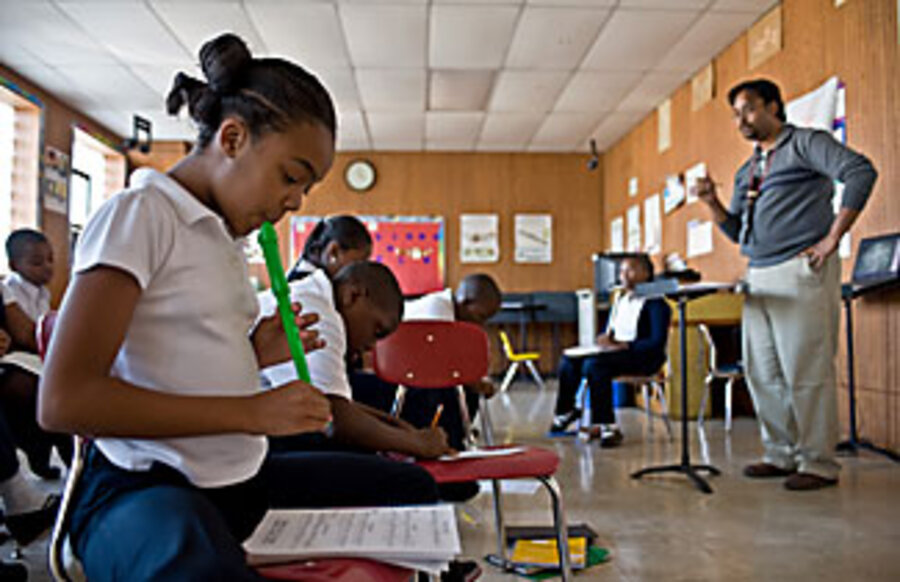Will a longer school day help close the achievement gap?
Loading...
| Chicago
Going to school from 8 a.m. until 5 p.m. may sound like a student's nightmare, but Sydney Shaw, a seventh-grader at the Alain Locke Charter Academy on Chicago's West Side, has come to like it – as well as the extra 20 or so days that she's in class a year.
"I'm sure every kid at this school says bad things about the schedule sometimes," says Sydney, who was at school on Columbus Day, when most Chicago schools had a holiday. "But deep down, we all know it's for our benefit."
Finding ways to give kids more classroom time, through longer hours, a longer school year, or both, is getting more attention. President Obama and Education Secretary Arne Duncan support a lengthier timetable. Many education reformers agree that more time at school is a key step.
Charter schools like Alain Locke and KIPP schools (a network of some 80 schools that are often lauded for their success with at-risk students) have made big gains in closing gaps in student achievement, partly through expanded schedules. Other schools have been making strides, too – notably in Massachusetts and in the New Orleans system.
"If you want to look at schools where [the achievement gap is narrowing], they're saying they couldn't do it without the added time," says Jennifer Davis of the National Center on Time & Learning in Boston. "Even when you get good teachers into schools, you need added time."
According to studies, low-income students lose more than two months of reading skills over the summer. One conclusion from the studies: More than half the achievement gap between lower- and higher-income students can be accounted for by the differential in summer learning opportunities.
"It's over the summer months that disadvantaged kids fall behind," says Karl Alexander, a sociologist at Johns Hopkins University in Baltimore. "If you have parents who themselves didn't succeed in school and aren't highly literate, kids aren't going to get those skills at home."
Some skeptics say that while extended learning time sounds great, adding hours and days to the school year can be hugely expensive. By itself, they say, it will accomplish little: If the school is already falling short, more time there won't help anyone.
"It's not a turnaround strategy," says Elena Silva, a senior policy analyst at Education Sector, an independent think tank. "If you extend time in schools that ... lack good teachers and lack good curriculum ... that's the worst thing you could do."
She also emphasizes the expense. Although charter schools like Alain Locke aren't bound by union rules, most schools are, which means that adding significant time to teachers' schedules can produce big costs.
Neither Secretary Duncan nor Mr. Obama has put forward a specific proposal to change the school calendar, but both have talked about the need to reform it.
"Young people in other countries are going to school 25, 30 percent longer than our students here," Duncan told the Associated Press recently. "I want to just level the playing field."
One program that has attracted attention is the Expanded Learning Time Initiative (ELT) in Massachusetts, which Ms. Davis helped found. Since 2004, 22 schools in the state have chosen to become ELT schools, adding at least 300 hours to their school year, mostly through longer school days.
Schools are asked to take a full year to plan how to best use the extra time – a process involving teachers, principals, union officials, and parents. They're given outside support to help them base their plans on the best available data and analyses of student needs. The cost is an extra $1,300 per child, paid with state resources.
"It's been very cost-efficient compared to some of the other investments in education," Davis says. It's still early in the program for many results, but officials are already seeing stronger test scores and a narrowing achievement gap, she says.
Edwards Middle School in Boston was slated to be closed in 2002 for underperformance, and it posted the lowest math scores in the district. The school used ELT funds to add four hours a week of math instruction – including less-traditional methods. Now, it's outperforming the state average in math and cut its language-arts achievement gap by 80 percent.
Davis has hopes for a national program, outlined in a bill that would commit some federal dollars. The late Sen. Edward Kennedy introduced the bill, called the TIME Act, last summer.
But a grander scale for programs like the Massachusetts one worries some critics, who say that experience has shown that reforms will rarely be done as thoughtfully.
"We risk producing something that's very expensive, time-consuming, [and] distracting, and frankly [it] will make the lives of educators even more harried," says Frederick Hess, director of education policy studies at the American Enterprise Institute in Washington. Replicating the Massachusetts model nationally could cost $50 billion a year, he says. "Before we borrow that much more money against our kids' futures, I'd much rather see if we can figure out how to wring 50 percent more instructional time out of the [current] school day," he says.
At Alain Locke, where 87 percent of the pupils are low-income, test-score gains at the elementary level have been the highest in Chicago since 2001. The school's success is clearly about more than extra time in class, but having that time, says principal Lennie Jones, has been crucial. It's allowed the school to include time for art, music, and recess, among other things.
Teacher burnout hasn't been an issue, says Ms. Jones, since teachers there get far more planning time than they would at most other schools. They also get more regular breaks: three weeks off after a 10-week school session.
"The number of things kids forget over their breaks has been reduced," says Jones. And after three weeks off, she adds, "they all tell us they're ready to come back."







